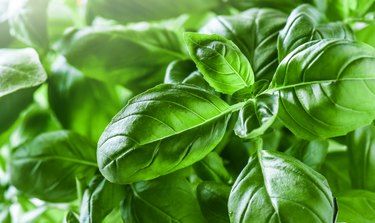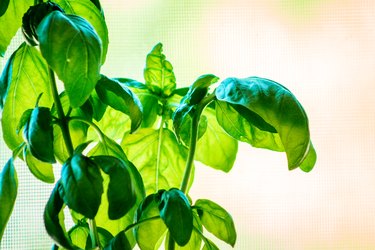
The most popular herb in the backyard garden is also the easiest to grow. Yes, that would be basil (Ocimum basilicum), an essential in Italian cooking, particularly indispensable for pesto. Basil's large leaves are extremely aromatic, and you can find cultivars in a fabulous array of flavors from lemony-mint to licorice. Given rich soil and plenty of sun, basil practically grows itself.
Unfortunately, a few garden pests appreciate basil as much as you do. If you're seeing holes in those basil leaves, you'll need to figure out the culprit, then tailor a response. This isn't as hard as it seems, since the short-list of critters only contains three names: Japanese beetles, slugs, or aphids.
Video of the Day
Video of the Day
Growing Healthy Basil
A vigorous, healthy basil plant resists pests better than a weak one. Taking great care of your basil is just a matter of giving it a proper location and adequate nurture. Basil needs a full-sun site and well-draining soil that is rich in organic matter. Don't squeeze basil between other plants. Give it ample elbow room to allow good air movement. For best growth, basil needs regular watering, but avoid overhead irrigation. Basil works well as a container plant and can be grown as an annual herb in any region. You can start a plant by planting seeds or by rooting a cutting.
When a garden pest is eating your basil leaves, they leave "evidence" to help you identify the specific culprit. It's usually possible — and always better — to take care of the problem with natural remedies rather than chemical pesticides.

Identifying Japanese Beetles
Start keeping an eye out for Japanese beetles in late spring or early summer. They are chunky, metallic green insects that devour basil from the top down. However, they won't touch the leaf veins. If you see lacy-looking basil foliage, you'll know who has left a mark.
But how do you get rid of them? First, try picking them off by hand. These beetles usually feed during the day and are very visible. Another option is to place a bowl of soapy water under the basil and shake the plant repeatedly until you dislodge the bugs. You'll also find special Japanese beetle traps in garden stores.
Dealing with Slugs
The other large pest that loves basil is the slug. You may not catch slugs chewing holes in the plant leaves because they eat at night, usually when the weather is wet. But slugs leave slime trails wherever they go. You can probably suspect slugs are the ones causing damage if you see holes in the lower basil leaves and stems, rather than the upper sections.
Slugs can also be picked off by hand if you are willing to track them down after dark with a flashlight. If you are a bit too squeamish for hand-collecting slugs, set beer traps for them. Put out low bowls of beer under the plant, and check them first thing in the morning. You can also make a circle of diatomaceous earth around the basil plants. This product contains sharp grains that scratch slugs that cross it, leading to dehydration and death.
Getting Rid of Aphids and Leafhoppers
Not all bugs eating basil are large enough to spot and grab easily. For example, if your plant has aphids, you'll have to look hard to spot them. Search for these soft-bodied insects if your basil plant's leaves look deformed or are turning yellow. Aphids are very common garden pests that look like moving dots on the leaves. They only become worrisome when their populations soar. That's when you'll notice plant damage. This usually happens when ants get involved by "managing" the aphids to eat the sweet substance they excrete, called honeydew.
When it comes to battling aphids, dish soap is a powerful weapon. Mix a few tablespoons of liquid dish soap into a gallon of water. Spraying this on the basil leaves gets rid of aphids quickly. After a half hour or so, rinse the soap (and dead aphids) from the plant. Alternatively, use insecticidal soap or buy ladybugs to devour the aphids.
If the pests eating your basil leaves are a species of leafhopper, you will see the channels they dig in before you see the small insects, each less than 1/4 inch long, with neutral tan coloring. Deal with leafhoppers by spraying the plant with horticultural oil, neem oil, or insecticidal soap.
No matter the bug problem, you can use these solutions to keep your basil looking fresh and healthy.